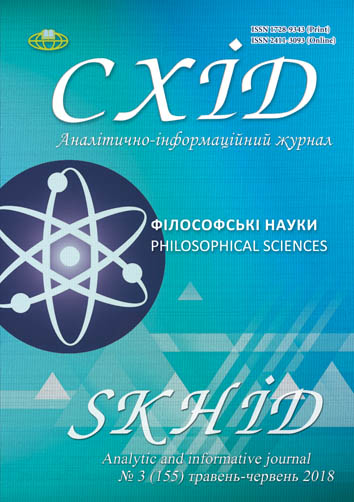Simulation of laughter: the experience of reconstruction
DOI:
https://doi.org/10.21847/1728-9343.2018.3(155).139403Keywords:
laughter, postmodern simulation of laughter, social functions of laughterAbstract
The paper looks into a phenomenon of postmodern simulation (simulacrization) of laughter. A historical reconstruction of the simulation process of laughter is made on the basis of a universal simulation algorithm proposed by J. Baudrillard, some intermediate counterpoints and kinds of postmodern simulated laughter identified.Downloads
References
Bart, R. 2004. Empire of signs [translat.]. Praxis,Moscow: 144 p. (rus).
Baudrillard, Jean 2004a. Simulacra and Simulation [translat.]. Osnovy, Kyiv, 230 p. (ukr).
Baudrillard, Jean 2004b. Symbolic exchange and death [translat.]. Calvaria, Lviv, 376 pp. (ukr).
Cannon, Waiter (December 1927). The James-Lange Theory of Emotions: A Critical Examination and an Alternative Theory. The American Journal of Psychology. No. 39: 106-124. DOI: 10.2307/1415404.
Carnegie, D. 2006. How to Win Friends and Influence People [translat.]. Martin Publ.,Moscow, 400 p. (rus).
Franzini, R. Louis. 2002. Kids Who Laugh: How to Develop Your Child’s Sense of Humor. Square One Publishers, Inc, 2002. 153 pp. (eng).
Klossowski, P. 1994. Simuliakr Georges Bataille [translat.]. In: Thanatology of Eros. Mithral Publishing,St. Petersburg: 82 (rus).
Kononenko, M.V. 2005. The command «ridiculous» Ogonyok: journal. № 28 (4907) for July 11-16 (rus).
Kremin, V.G. and Ilyin, V.V. 2006. Simulakr. Philosophy: Logos,Sofia, Reason. Knyha Publishing, Kyiv, 432 p. (ukr)
Levchenko, V. 2006. Laughter as a distinction. Doksa. Collection of scientific works on philosophy and philology.OdessaNationalUniversity. Issue. 9: 137-142 (ukr).
Makovetskiy, E.A. 2004. Social analytics of rhythm. Gilles Deleuze or of salvation. Publishing House of St. Petersburg University,St. Petersburg(rus).
Maltseva, O. V. 2010. Formalization of emotions as a means of informal communication in a virtual space. University science-2011: International scientific - technical. Conf., Priazovsky State Technical University, Mariupol, May 18-20, 2010 Mariupol: GSTU «PSTU», 2010. Vol. IIІ: 255 (ukr).
Maltseva, O. V. 2011. Flash mob as a situational and provocative manifestation of postmodern worldview. University science-2011: International scientific - technical. Conf., Priazovsky State Technical University, Mariupol, May 17-19, 2011 Mariupol: GSTU «PSTU», 2011. Vol. IIІ: 224-225 (ukr).
Maltseva, O. V. 2012. «Keep smiling!»: philosophical and socio-psychological foundations of the «American smile» The Newest Achievements of European Science-2012: VII I International Scientific Practical Conference,Sofia, 17-25 July 2012.- Sofia: «WhiteGRAD-BG» Ltd, Vol.8: 35-37 (ukr).
Maltseva, O. V. 2015. Reproduction of simulation models and their meanings: Footage laughter. Modern scientific trends: III (LV) International scientific-practical conference on philosophical, philological, legal, pedagogical, economic, psychological, sociological and political sciences, Kyiv, March 27, Pantyukh Yu.F. Publisher, Kyiv: 1-4 (ukr).
McKean, Erin. 2005. The NewOxfordAmerican Dictionary. 2. - adds ‘LOL’, ‘BFF’; other slang. Square One Publishers, Inc, 2051 pp. (eng).
Okorokov, V.B. 2006. Face and folds of the society (Transgression of laughter) Doksa. Collection of scientific works on philosophy and philology.OdessaNationalUniversity. Issue. 9: 71-78 (ukr).
Orben, R. 1986. 2100 Laughs for All Occasions. Main Street Books, 240 pp. (eng).
Plessner, Helmut. 2003. Laugh and cry. An Examination of the Limits of Human Behavior 1941. Expression and Human Nature. Collected Works VII. Frankfurt amMain: 201-387 (germ).
Zupančič, A. 2004. Eros and Comedy, or Subject and Surplus Pleasure [translat.]. Gender Studies. No. 11: 5-23 (rus).
Žižek, S. 2004. Giggle me please. Slavoj Žižek about passive perception and laugh track. Available at: http://www.vavilon.ru/textonly/issue12/zhizhek.html
Downloads
Published
How to Cite
Issue
Section
License
Copyright (c) 2018 Olha Maltseva

This work is licensed under a Creative Commons Attribution-NonCommercial-NoDerivatives 4.0 International License.
1. Authors bear responsibility for the accuracy of facts, quotations, numbers and names used.
2. Manuscripts are not sent back.
3. The publisher does not always agree with the authors' opinion.
4. The authors reserve the right to authorship of the work and pass the first publication right of this work to the journal under the terms of a Creative Commons Attribution-NonCommercial-NoDerivatives 4.0 International License. This license allows others to distribute (copy) the published work for non-commercial purposes, provided there is mandatory attribution to its authors and a link to the first publication in our journal.
5. The authors have the right to conclude separate supplement agreements that relate to non-exclusive work distribution in the form in which it has been published by the journal (for example, to upload the work to the online storage of the journal or publish it as part of a monograph), provided that the reference to the first publication of the work in this journal is included.

